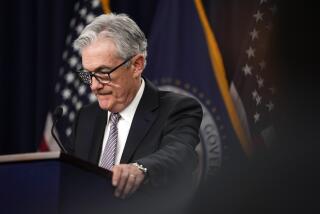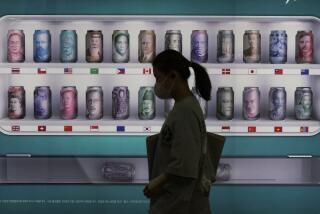The Euro’s Uncommon Swoon
PARIS — The European economy’s horror story--call it “The Incredible Shrinking Euro”--goes on, with no end in sight.
After a week in which the common currency of 11 member countries of the European Union suffered its sharpest one-day drop ever against the U.S. dollar, the euro this week has been taking a drubbing at the hands of a newly invigorated Japanese yen.
The yen finally took a break Wednesday after gaining nine straight days against the hapless euro. The euro edged up to 102.93 yen in New York trading, from Tuesday’s record low of 100.95.
Meanwhile, the single currency remained near its lifetime low of 93.90 cents, reached Monday, and well below the $1 parity once seen as a benchmark of respectability. By late Wednesday it had climbed to 96.11 cents.
The euro is down 17% from the $1.17 it was worth when it was created 14 months ago.
The euro’s weakness threatens to reawaken inflation in the European bloc and is increasing pressure on the new European Central Bank to raise interest rates.
With the world financial community looking on, leaders of the ECB, the euro’s controlling authority, meeting last week in Frankfurt, Germany, left interest rates unchanged. But they indicated that the euro’s nagging anemia and a pickup in European inflation soon will prompt a rate hike.
“There can be no doubt in anyone’s mind about the direction of monetary policy,” ECB President Wim Duisenberg said.
The euro has gone into a swoon, analysts say, because European growth--though the healthiest in years--is being outpaced by the scorching U.S. economy. The euro rose above parity with the greenback two weeks ago, but plummeted again when figures showed the U.S. economy grew by a blistering annualized rate of 6.9% in the fourth quarter of 1999.
Recent signals from Federal Reserve Chairman Alan Greenspan that another increase in U.S. interest rates is in the offing also have reinforced the dollar in relation to other currencies, including the euro.
Many of Europe’s politicians have been calling for an increase in the value of the currency that, to a large part of public opinion, is synonymous with European economic might. “A stable and strong euro is in the best interest of Europeans,” Spanish Finance Minister Rodrigo Rato said.
Some analysts say a crisis in confidence in the relatively new currency seems a real risk. In Asia, some traders say that they are receiving large sell orders, but that nobody seems to want to buy euros.
Analysts said the yen is strengthening in part because Japanese companies are converting overseas earnings into yen to include in their fiscal year, which ends March 31.
La Tribune, a Paris business daily, said Europe appeared “powerless” to shore up the currency’s value.
The ECB last raised its benchmark refinancing rate, by a quarter-point to 3.25%, on Feb. 3. But that wasn’t enough to ensure a long-term rise in the euro.
Faster growth and higher interest rates have continued to make the United States more attractive for investors.
A relatively cheap euro is a mixed blessing for the countries that have adopted it--Austria, Belgium, Finland, France, Germany, Ireland, Italy, Luxembourg, the Netherlands, Portugal and Spain. It makes their exports cheaper in foreign markets and encourages foreign tourists to take advantage of the greater buying power of their currencies.
But a weak euro also means Europeans must pay more for dollar-denominated imports, especially petroleum, which is now at a nine-year high.
Those price increases can fuel inflation, a chain reaction about which the ECB is increasingly worried. In January, European inflation for the first time touched the 2% ceiling that the Frankfurt-based ECB is supposed to maintain. The price of imports in Germany, the euro zone’s largest economy, rose in January at the fastest pace since 1981.
On Thursday, Duisenberg acknowledged that there were “upside risks” for inflation, including costlier imports and Europe’s accelerating economic growth, expected to average 3% this year.
Some analysts said that in not boosting rates last week, the ECB wanted to avoid giving the impression that it was yielding to panic. “Nothing will happen before April,” said Klaus-Dieter Kuehbacher, a member of the governing council of Germany’s Bundesbank. Many economists anticipate a rate increase later this month or in April.
“There is not a lack of confidence in the euro, but confusion as to the ECB’s strategy and its communications policy,” said Jose Alzola, European economist with Salomon Smith Barney Citibank in London. “I think the ECB will hike interest rates in next few months in line with the Fed and, later in the year, go even higher than the Fed.”
He predicted the euro will rise back to parity with the dollar sometime during the summer, then keep increasing in value.
Despite the panicky talk in some financial media, Alzola said the bond markets prove that plenty of investors continue to have long-term faith in the euro.
“If you had a weakening currency and a lack of credibility in the ability of the ECB to keep inflation down in the medium term,” he said, “you would have seen a massive sell-off and higher yields.” Yet there has been no mass exodus from euro bonds, the Spanish-born economist said, and yields on 10-year paper are holding steady at around 5.5%.
“This is another sign that the weakness of the euro is more related to concerns about the relative cyclical positions of the European and U.S. economies rather than any loss of credibility by the European Central Bank,” Alzola said.
For the moment, the euro exists only for noncash transactions. In 2002, it will become the sole legal tender in euro zone countries, and coins and bank notes in euros will replace national currencies such as the Spanish peseta and Italian lira.
More to Read
Sign up for Essential California
The most important California stories and recommendations in your inbox every morning.
You may occasionally receive promotional content from the Los Angeles Times.










